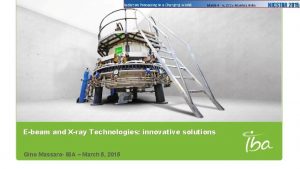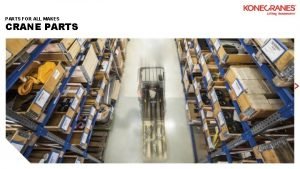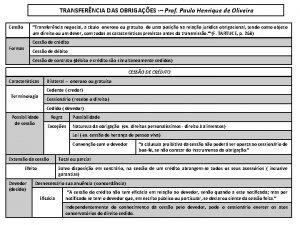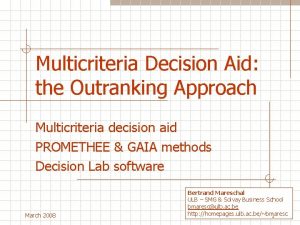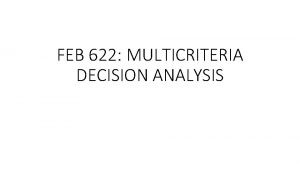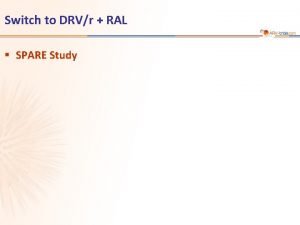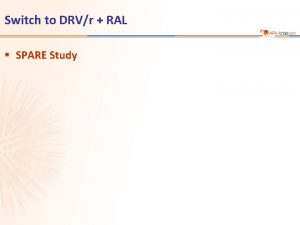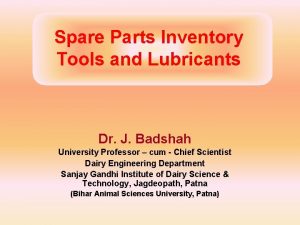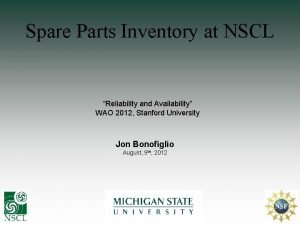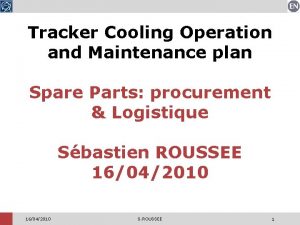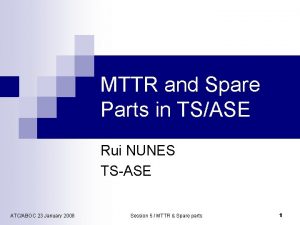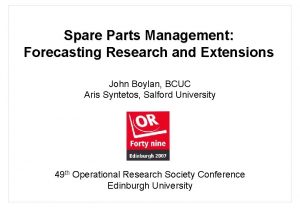MULTICRITERIA CLASSIFICATION OF SPARE PARTS Henrique Kriguer and
















- Slides: 16

MULTI-CRITERIA CLASSIFICATION OF SPARE PARTS Henrique Kriguer and Valerio Salomon Sao Paulo State University Valerio. salomon@Hotmail. com Sao Paulo Research Foundation (FAPESP) Grant 2013/03525 -7 and Grant 2016/04307 -1

Multi-criteria classification of spare parts 1. Introduction 2. Objectives 3. Methodology 4. Analysis 5. Conclusions References and future submission Kriguer and Salomon, 2016 2

Introduction Spare parts = parts of an equipment those can be replaced when its performance decreases Policies for spare parts inventories maybe different from WIP inventories and inventories of final products to be sold to a customer ABC Classification is a common practice for inventory management Kriguer and Salomon, 2016 3

Introduction Inventories of Class A items, the more valuable items, may be better controlled, on a daily basis, for instance On the other hand, inventories of Class C items may not be not controlled, with stock out replenishments The classification of spare parts by monetary value alone could be dangerous Kriguer and Salomon, 2016 4

Introduction This work proposes a multi-criteria classification with the Analytic Hierarchy Process (AHP) However, according to international literature, AHP is not indicated to Classification Problems Still, an AHP-based model was successfully implemented by a plant of capital goods located in the Brazilian state of Sao Paulo Kriguer and Salomon, 2016 5

Objectives The main objective of the research is to improve the method of classification of inventoried parts in a real company A specific objective is to determine criteria for inventory classification other than the monetary value The challenge is the AHP application against MCDM literature Kriguer and Salomon, 2016 6

Methodology The classification of spare parts with multi-criteria approach is the main contribution of this work A plant of capital goods adopts a mono-criterion approach for its spare parts classification They based only on the monetary value of the inventory to classified it as A, B or C Kriguer and Salomon, 2016 7

Methodology From Kennedy et al. (2002) and Bacchetti and Saccani (2012): Classification of spare parts Monetary Value Kriguer and Salomon, 2016 Demand Criticality Life Span Spare Time Ease of Obtainment 8

Methodology A Classification Problem involves a high number of alternatives that need to be grouped into classes Pairwise comparisons matrices are limited to order 9 (Saaty and Ozdemir, 2003) So, Ishizaka et al. (2012) proposed AHPSort But, what a about absolute measurement, also known as ratings (Saaty, 1986)? Kriguer and Salomon, 2016 9

Analysis Three senior managers were consulted, in a single session Criteria V D C L T Monetary value (V) 1 1/7 1 5 1/7 5 9% Demand (D) 7 1 7 7 1 Criticality (C) 1 1/7 1 5 1/7 5 9% Life Span (L) 5 1/7 1/5 1 1/7 1 3% Spare time (T) 7 1 1 7 7 Ease of obtainment (S) 1/5 1/7 1/5 1 Kriguer and Salomon, 2016 S Priority 7 38% 1/7 1 3% 10

Analysis However, managers have not consensus on the ABC distribution. Then, they judgment were aggregated by geometrical mean (Saaty and Peniwati, 2005) Kriguer and Salomon, 2016 Class A B C Priority A 1 3√(105) 3√(567) 73% B 3√(1/105) 1 3√(75) 21% C 3√(1/567) 3√(1/75) 1 6% 11

Analysis (original 5 Class A, 6 Class B, 21 Class C) Part Number Value [€] Value [%] Cumulative [%] Class Kriguer and Salomon, 2016 S 220 5, 412 18. 9 A C 365 3, 629 12. 7 31. 6 A T 001 3, 526 12. 3 43. 9 A M 444 3, 269 11. 4 55. 3 A S 665 3, 205 11. 2 66. 5 A A 124 2, 543 8. 9 75. 4 B F 254 2, 489 8. 7 84. 1 B … … … S 126 236 0. 8 96. 4 C … … … 12

Analysis (new 6 Class A, 21 Class B) Part Number V (9%) D (38%) C (9%) L (3%) T (38%) S (3%) Overall S 220 A C A A A C B C 365 A C C A B C B T 001 A C B A B C B M 444 A C A A B C B S 665 A C C A B C B A 124 A C B B B C B F 254 B C B B B C B … … … … S 126 C A B C A … … … … Kriguer and Salomon, 2016 13

Conclusions The empirical study presented AHP successfully applied to solve a multi-criteria classification problem, au contraire to international literature Plant managers validated the results AHP-based model was considered as a better practice for classification of spare parts AHP application begun with an expiring Expert Choice license, not renewed by EC, and not missed Kriguer and Salomon, 2016 14

Main references Bacchetti A, Saccani N (2012) Spare parts classification and demand forecasting for stock control, Omega 40, 722– 737 Ishizaka A, Pearman C, Nemery P (2012) AHPSort: an AHP based method for sorting problems, Int J Prod Res 50, 4767– 4784 Kennedy WJ, Patterson JW, Fredendall LD (2002) An overview of recent literature on spare parts inventories, Int J Prod Econ 76, 201– 215 Saaty TL (1980) Absolute and relative measurement with AHP. The most livable city in the United States, Socio-Econ Plann Sci 20, 327– 331 Saaty TL, Ozdemir M (2003) Why the magic number seven plus or minus two, Math Comp Model 38, 233– 244 Kriguer and Salomon, 2016 15

Future submission Extended version of this work shall be submitted to Special Issue of J Multi-Criteria Decis Anal Kriguer and Salomon, 2016 16
 Spare parts rhodotron
Spare parts rhodotron Tata motors swot
Tata motors swot Konecranes parts
Konecranes parts Ato de supremacia de henrique viii
Ato de supremacia de henrique viii Mediata e imediata
Mediata e imediata Ato de supremacia de henrique viii
Ato de supremacia de henrique viii Henrique grunspun
Henrique grunspun Henrique veiga inventor
Henrique veiga inventor Pnld 2021
Pnld 2021 Pedro henrique casagrande oliveira
Pedro henrique casagrande oliveira Carlos henrique marcondes
Carlos henrique marcondes Henrique nono
Henrique nono Henrique inglesa
Henrique inglesa Henrique oliveira art
Henrique oliveira art Pharmacodynamics
Pharmacodynamics Spare receptors
Spare receptors Quantal dose
Quantal dose
